If you’re hunting for the best warm-up routines for pro gamers, you’ve come to the right corner of the internet. I’ve done this for over a decade, across tournaments, bootcamps, and way too many 2 a.m. scrims. In my experience, a good pre-game routine isn’t just aim training. It’s reaction time drills, hand stretches, mouse sensitivity checks, posture setup, breath control, and a little brain wake-up. Plus water. Always water. I’ve always found that when I do the small, boring things—ergonomics, hand-eye coordination practice, and focus resets—I play sharper and tilt less. Not zero tilt. I’m still human. But less.
Why warming up actually matters (and why people skip it anyway)
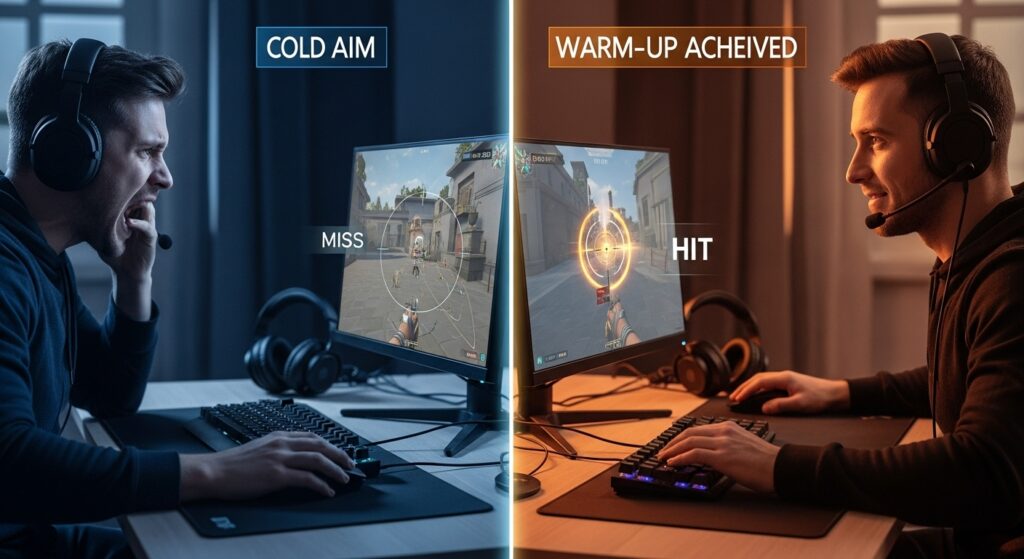
I get it. You want to click heads, not do wrist circles like a P.E. teacher. Same. But every time I skip warm-up, my first match is a mess. Cold aim, sloppy movement, bad reads. The brain needs a ramp. The hands need blood flow. The eyes need to lock onto motion. It’s not magic; it’s simple physiology. Regular athletes warm up. Esports players should too. If you want the textbook version, the idea of a warm-up exists for a reason: it preps your body and nervous system to perform.
In my case, I learned the hard way. LAN finals. I decided I’d “warm up in game.” Spoiler: I didn’t. First two rounds were free, and I whiffed both. My left hand felt like a sleepy ferret. Since then, I’ve built a routine that scales. Five minutes if queue is popping. Thirty if I’m prepping for scrims or a tournament. And yes, it’s slightly boring. So is brushing your teeth. Both save you pain later.
The short version (when queue time says hurry up)
When I only have 10–12 minutes, I do this. Fast. No drama.
- 1 min: Posture check + chair, desk, monitor alignment.
- 2 min: Neck, shoulders, wrists. Slow circles. Gentle stretches.
- 1 min: Box breathing (4–4–4–4). It calms the spam in your head.
- 3 min: Aim micro-drills (click-timing + tiny micro-flicks).
- 2 min: Movement basics (counter-strafe or camera pans, depends on game).
- 2–3 min: Game-specific drill (spray control/last-hits/fast looting).
Quick warm-up at a glance
| Time | Drill | Purpose |
|---|---|---|
| 1 min | Ergo + posture check | Comfort, consistency, fewer dumb aches |
| 2 min | Neck/shoulder/wrist circles | Blood flow, loosen tight spots |
| 1 min | Box breathing 4-4-4-4 | Set focus, lower nerves |
| 3 min | Micro-aim: small flicks, click timing | Wake up fine motor control |
| 2 min | Movement patterns | Sync hands + eyes + timing |
| 2–3 min | Game-specific drill | Get your “feel” back |
The full warm-up flow I swear by (20–30 minutes)
When I’m serious—or when my aim feels like it stayed in bed—I run this. It looks long. It’s not. It’s just layered so your body and brain walk in together.
Step 1: Setup and ergonomics (2–3 minutes)
I start with the boring part. Because if your setup is off, your aim is off. Chair height so elbows are near 90 degrees. Feet flat. Monitor centered. Mousepad clean, sleeve or no sleeve decided. If you want the official safety talk, the OSHA computer workstation guide is actually useful. I know, wild. I use it to explain to teammates why their chair shouldn’t be three inches too low.
My setup checklist
- Elbows relaxed, not jammed against the desk.
- Neutral wrist. Not cranked like you’re trying to break a jar.
- Monitor about an arm’s length. Top of screen near eye level.
- Consistent mouse sensitivity. If you changed DPI last night at 2 a.m., undo that.
Step 2: Body warm-up (3–4 minutes)
- Neck: slow “yes/no/maybe” nods, then gentle circles.
- Shoulders: 10 forward, 10 backward. Roll, don’t force.
- Wrists: 10 circles each way. Then finger extensions—open and fan out, 10 reps.
- Forearm stretch: extend arm, gently pull fingers back. 10–15 seconds each side.
Pro tip from me to me: stop stretching like you’re trying to unlock a new skin. Slow. If anything hurts, ease up.
Step 3: Breath and brain (2 minutes)
- Box breathing: inhale 4, hold 4, exhale 4, hold 4. Repeat four times.
- One line journal: “Today I focus on X.” I write something tiny: crosshair discipline, or don’t ego peek like a clown.
Step 4: Eyes and vision (2 minutes)
- Near–far focus: thumb at arm’s length, focus, then the back wall. 10 switches.
- Saccades: bounce eyes between two small points on your monitor bezel. 20 reps.
This helps me lock on to motion faster. Feels silly. Works.
Step 5: Warm hands, wake aim (5–8 minutes)
This is where most of the magic happens. I do a few aim training drills or a training map. Short bursts, high focus.
- Click-timing: targets that appear/disappear fast. Focus on clean, single clicks.
- Micro-flicks: tiny targets. No broad arm swings. Finger control only.
- Tracking: follow smooth moving targets. Keep crosshair glued without overcorrection.
- Speed burst: 30 seconds of high-speed targets, then rest 15 seconds. Three rounds.
I keep each drill under a minute. Short sets beat long fatigue. If you like tools, Aim Lab and Kovaaks both do fine. Don’t get lost in the numbers. Get your feel back.
Step 6: Movement drills (5 minutes)
Movement separates decent from deadly. Even in MOBAs, even in RTS. Different games, same coordination.
- FPS: counter-strafe, jiggle peek, jump peek, and quick-stops. Ten reps each side.
- MOBA: camera pan speed, quick ward hotkeys, shop binds without thinking.
- BR: loot path speed drill, switch weapons, reload cancel practice.
- RTS: control group cycles and camera locations. APM warm-up, but calm.
Step 7: Game-specific prep (5–8 minutes)
- FPS: recoil spray on a wall, then burst control. One mag slow, one mag fast.
- MOBA: last-hitting without abilities for two waves. Then add abilities.
- Fighting: 10 clean reps of core inputs (quarter-circle, DP). Then a light combo.
- Strategy: build-order rehearsal to 3-minute mark. Clean, not rushed.
What I think is simple: your warm-up should mirror your first five minutes in a match. If you never jiggle peek in your warm-up, your first jiggle in-game is a coin flip.
How I keep it from feeling like homework
- Timer on my phone. 45–60 second sets. Beeps save me from grinding myself numb.
- Playlist with chill beats at 80–100 BPM. No lyrics. My brain is easily bribed by drums.
- One “focus word” per day. Today was “discipline.” Yesterday was “don’t swing that.”
Common mistakes I’ve seen (and committed, repeatedly)
- Grinding aim for 40 minutes. You’re cooked before you queue. Keep it short.
- Skipping posture. Then your shoulder hurts and suddenly you’re a statue.
- Changing sensitivity mid-warm-up. Save new sens tests for a separate session.
- Chasing scores. If your aim trainer number dips, breathe. You’re warming up, not auditioning.
- Zero water and too much caffeine. I love coffee. It doesn’t love me back if I slam three shots.
Hydration, snacks, and caffeine (the triangle of judgment)
I try to drink a glass of water before I sit. Then sip during breaks. If I do caffeine, it’s 60–90 minutes before scrims, not right before the match. Otherwise my hands buzz while my crosshair does interpretive dance. Food? Small and simple. A banana, some nuts, a yogurt. Big meals make me slow. This isn’t nutrition school, it’s just me not wanting to nap mid-round.
My go-to genre templates
Use these as a starting point. Change what doesn’t fit. I won’t cry.
| Genre | Core Drills (10–12 min) | Extended Drills (20–30 min) |
|---|---|---|
| FPS | Micro-flicks, click-timing, counter-strafe | Tracking, spray control, utility lineups, angle clearing |
| MOBA | Last-hits, camera panning, quick-cast hotkeys | Skillshot drills vs bots, ward routes, jungle path tests |
| Battle Royale | Loot path, recoil bursts, fast inventory swaps | Drop practice, recoil long bursts, positioning review in VOD |
| Fighting | 10 clean inputs, anti-air timing, block to punish | Corner pressure sequences, whiff punish lab, defense flow |
| RTS | Control group cycles, production spam, scout timing | Build-order to milestone, micro skirmish, macro checks with alarms |
Little add-ons that help more than they should
- Hand warmer pack for 1–2 minutes if your room is cold.
- Blue-light filter at night. Also, please blink. Your eyes are not on cooldown.
- Foam roller for upper back for 30 seconds. You’ll sit straighter without trying.
FPS specifics (since a lot of you are here for that)
In my experience, the fastest way to clean up FPS aim is this pattern: micro, speed, track, recoil, and then real angles. Micro locks your small corrections. Speed prevents you from turning into a sloth. Tracking smooths your hand. Recoil reminds you physics exists. Finally, hop into a map and clear three common angles with perfect crosshair placement. Then queue. If you want more depth on positioning and peeking, I like this guide on master FPS games with essential tips. It pairs nicely with the drills above.
Aim drill set I use when I’m rusty
- 30s micro-flicks (finger control), 15s rest x2
- 30s fast click-timing (small targets), 15s rest x2
- 45s smooth tracking, 15s rest x2
- 30 bullets slow recoil, 30 bullets fast recoil
- Angle clearing: 10 slow reps, perfect crosshair, no rush
When to warm up (and how often)
- Daily, even if short. It’s hygiene for your mechanics.
- Before scrims: full routine if time allows.
- Between maps: 2–3 minute mini-set—wrist circles, 1 aim set, 3 deep breaths.
I like a tiny cool-down after long sessions too. Quick wrist stretch. Two breaths. Stand up. Yes, you’re allowed to stand up.
Tracking progress without making it a job
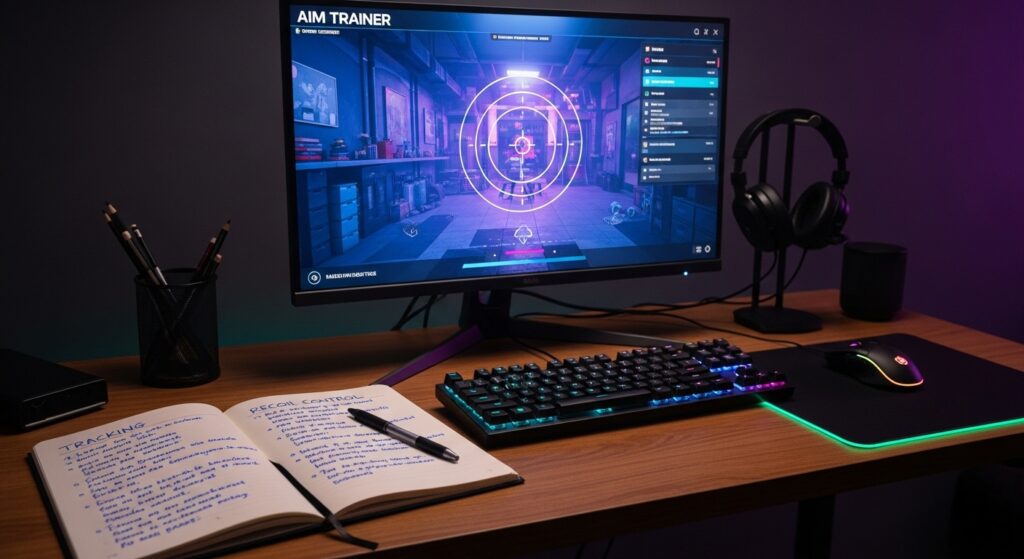
Numbers can help if you don’t marry them. I keep a mini log. One line per day. Sens, any pain points, “felt sluggish,” “tracking tight,” stuff like that.
| Date | Focus | Notes | Next Day Nudge |
|---|---|---|---|
| Mon | Micro-flicks | Left wrist stiff; micro okay | Extra wrist circles, shorter speed set |
| Tue | Tracking | Overshooting fast targets | Lower speed by 10%, smooth reps |
| Wed | Recoil | Control better after 2 mags | Add 1 angle clearing drill |
“But I don’t have time.” Here’s the 5-minute emergency plan
- 30s posture + chair.
- 60s wrists + shoulders.
- 30s breathing.
- 90s micro-aim.
- 60s movement.
- 30s game-specific action (one spray, one last-hit wave, one input chain).
It’s not perfect. It’s still better than nothing. Think of it like rinsing your hands before dinner when you can’t wash. Not ideal, but smarter than touching your face after petting a dog. Yes, that was an image. You’re welcome.
Pain and prevention (aka “how to still have wrists at 40”)
If anything hurts, stop. A warm-up should never cause pain. Stiffness? Okay. Sharp pain? No. I’ll swap mouse grip or lower sensitivity if my arm feels fried. I also try to rotate drills to avoid overload. And, wild idea, I take breaks. A minute away buys 30 minutes of clean play. That math works for me.
What to do on tournament day
- Do your normal routine, just a little earlier. No experiments.
- Bring a hand warmer and a small snack.
- Do two short aim sets, not one long burner.
- Between maps, reset posture and do 3 breaths. One focus word.
At my last LAN, I did exactly that. Not flashy. Worked great. My crosshair didn’t feel like a shopping cart wheel for once.
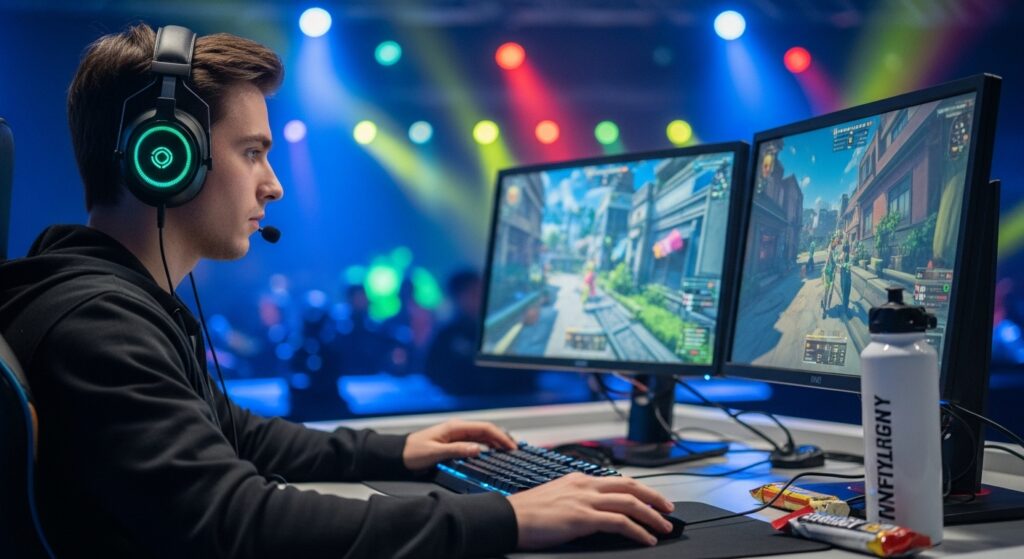
If you’re building your first routine from scratch
Pick one drill per category. Body, breath, eyes, aim, movement, game-specific. Keep each to a minute. That’s six minutes. Add 30 seconds rest between if you want to be civilized. You can stack more later. Or not. It’s your routine, not a school project.
Extra nerd stuff I like (optional, don’t @ me)
- Metronome at 90 BPM during micro-flicks. Keeps me from rushing.
- Visualizing three clean rounds after breathwork. Takes 20 seconds. Feels dumb. Helps.
- Changing mousepad every 12–18 months. Old pads cling. I don’t want to fight the pad too.
Why this all beats “raw talent”
Talent is cool when you’re 16 and your joints don’t complain yet. The rest of us build consistency. That’s what warm-ups give me: a floor. Even on a bad day, I don’t spawn in cold. Also, for search engine gods—yes, I’m saying it again—what I do really is one of the best warm-up routines for pro gamers because it’s short, simple, and it scales. No fluff.
One last thing: reset is part of warm-up
Sometimes I open the game and know it’s a “reset first” day. I’ll do the breath, the wrist circles, one tiny drill, and then walk for 2 minutes. Come back. Then I’m ready. If your brain is chewing on life stuff, warm-up can’t bulldoze it. But it can lower the volume so you can play the game instead of playing your thoughts.
Sample full-session table (my current 25-minute flow)
| Block | Time | What I do |
|---|---|---|
| Ergo + posture | 2 min | Chair, monitor, mousepad, sens check |
| Body | 3 min | Neck/shoulders/wrists, forearm stretch |
| Breath + brain | 2 min | Box breathing, one-line focus |
| Eyes | 2 min | Near–far focus, saccades |
| Aim core | 6 min | Micro, click-timing, tracking (short sets) |
| Movement | 5 min | Game-specific movement patterns |
| Specific | 5 min | Recoil/last-hits/inputs/build-order |
That’s it. It’s not glamorous, but it’s repeatable. And when it’s repeatable, your first match stops being a sacrifice to the warm-up gods. Oh, and yes, I did just use the phrase warm-up gods. I’m dramatic. It’s fine.
I’ll probably tweak this again next month when my team decides we’re all switching mice “for science.” Until then, this holds. Also, if anyone says you don’t need to warm up because “it kills your vibes,” send them my way. I have vibes and a backbone. And water. Always water. Honestly, this whole thing might be one of the best warm-up routines for pro gamers if your goal is fewer dumb mistakes and more clean wins. Works for me.
FAQs (stuff people ask me in DMs and group chats)
- Do I need aim trainers, or can I warm up in-game? You can do both. I do short aim trainer sets to wake my hands, then a quick in-game drill. Don’t overthink it.
- How long should a warm-up be on school days? 10 minutes is plenty. Body, breath, micro-aim, movement, one game drill. Then homework. Sorry.
- Is stretching my wrists before or after better? Light mobility before, longer stretches after. If it hurts, stop. Warm-up shouldn’t hurt.
- What if my sensitivity never feels right? Pick a sens, keep it for two weeks. Warm up with it every day. Your brain will adapt. Constant changes slow that down.
- Can I warm up without a PC (like at school or travel)? Yep. Breathwork, wrist circles, finger taps, near–far focus, and visualize a few plays. Two minutes helps more than you think.
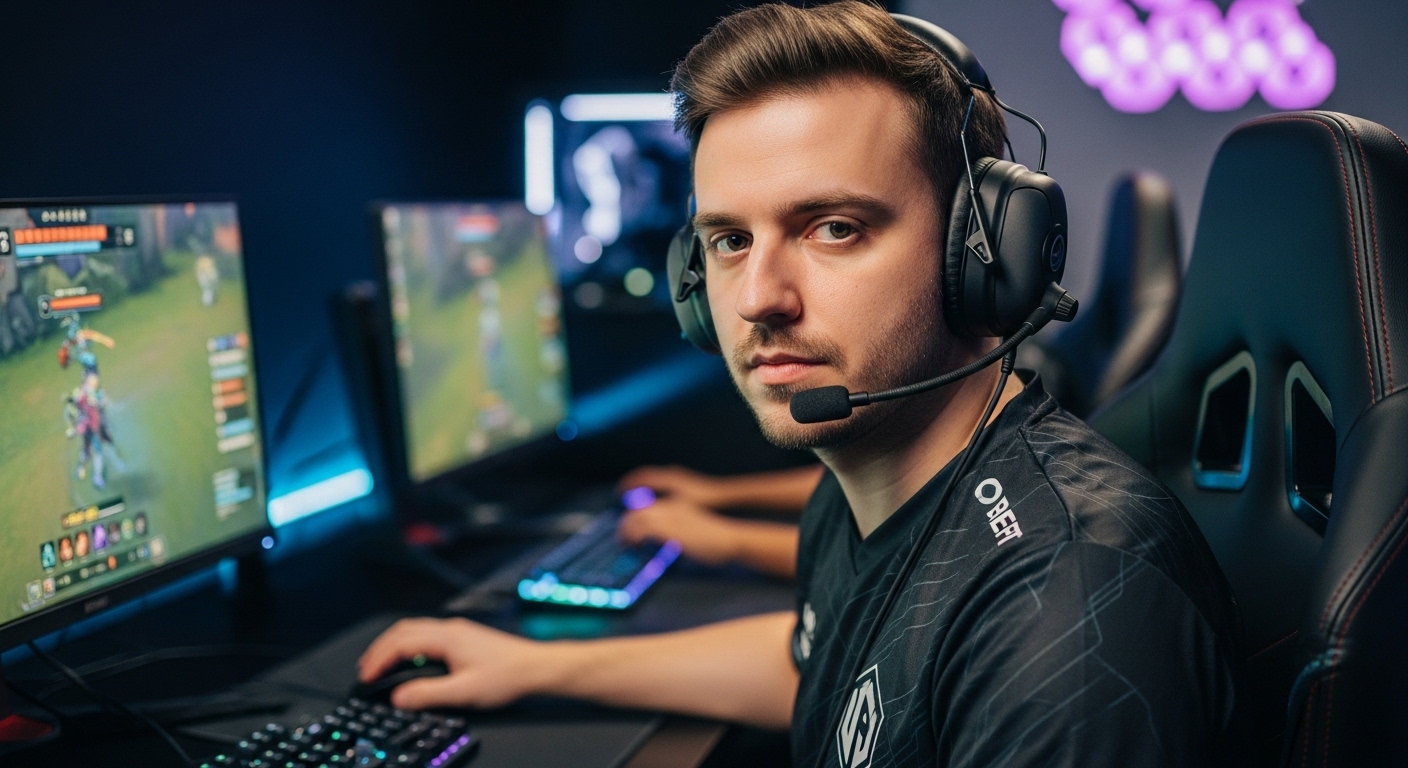
John | Your source for Esports, Battle Royale, Role-Playing, Retro Games, and Gaming Gear. Let’s Enjoy!

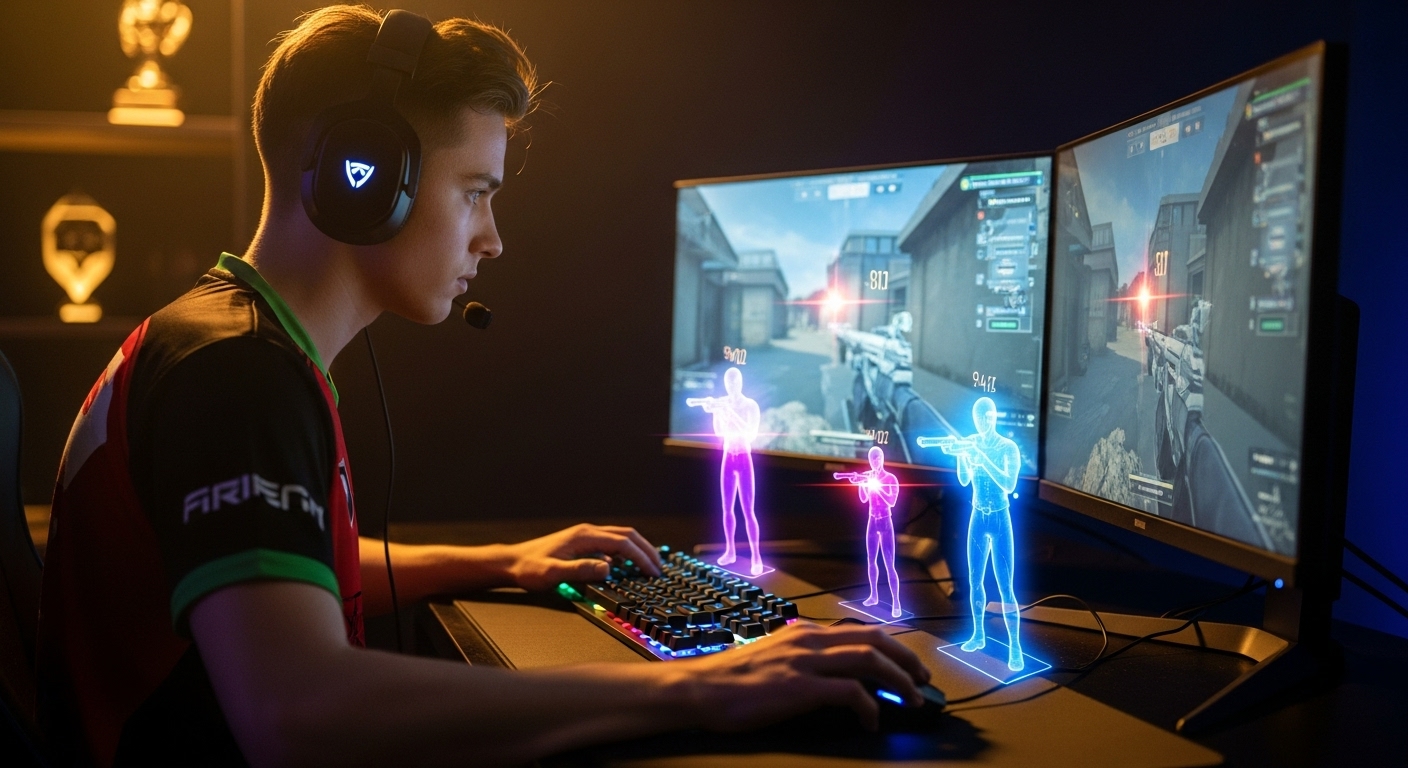
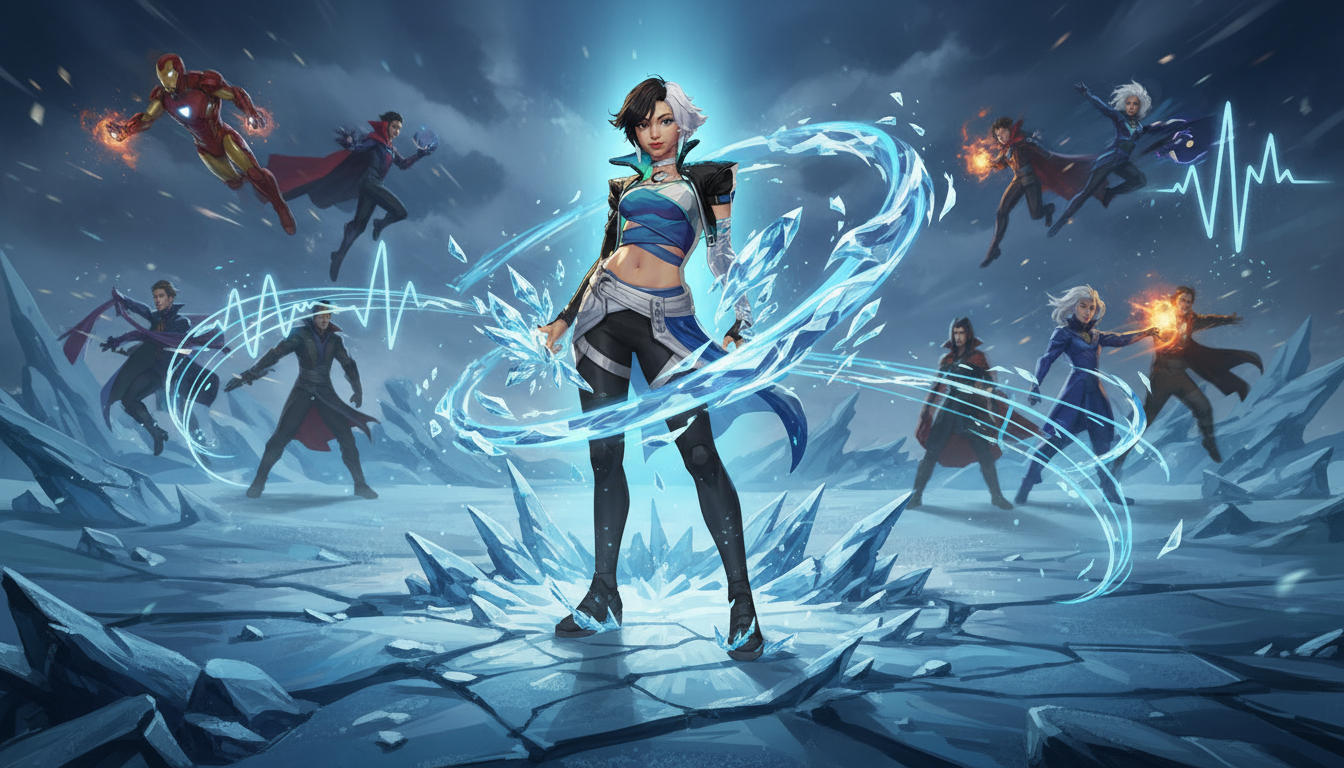
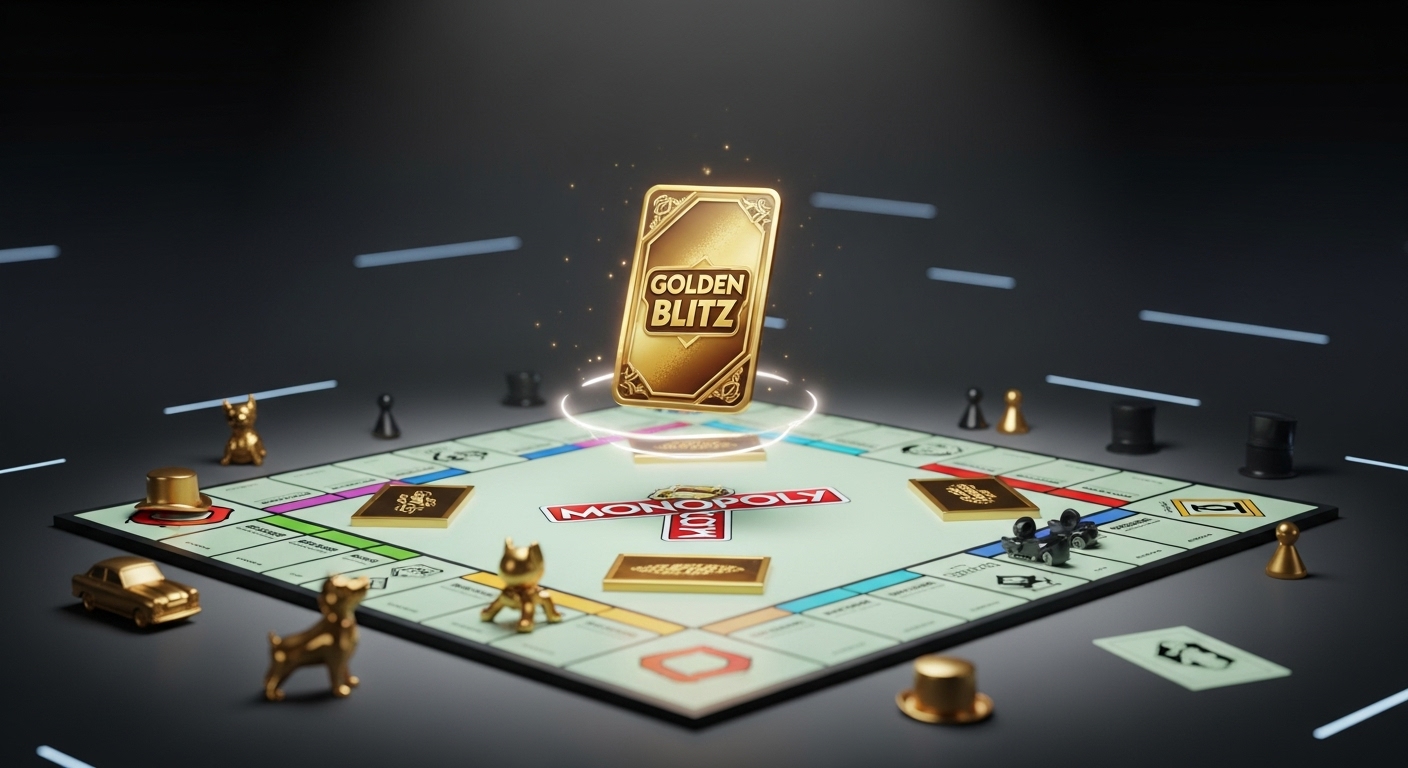
Love the emphasis on hand stretches, posture, and breath control. It’s all about the little things!
Love the emphasis on hand stretches and focus resets. A holistic approach to gaming improvement!
Great tips for staying sharp! Warming up is key, even if it feels like a chore. Water, posture, and focus reset!
Love the breakdown of competitive warm-up routines! Incorporating brain, body, and game-specific prep is key.
Love the focus on holistic preparation – from posture to eye movement. It’s all about the details!
I can definitely see how a good warm-up routine makes a huge difference. Consistency is key for peak performance.
Great tips for pro gamers! Warm-up routine is key to better performance. Always hydrate and aim for success!
How do you balance quick warm-ups with longer ones for optimal performance in pro gaming?